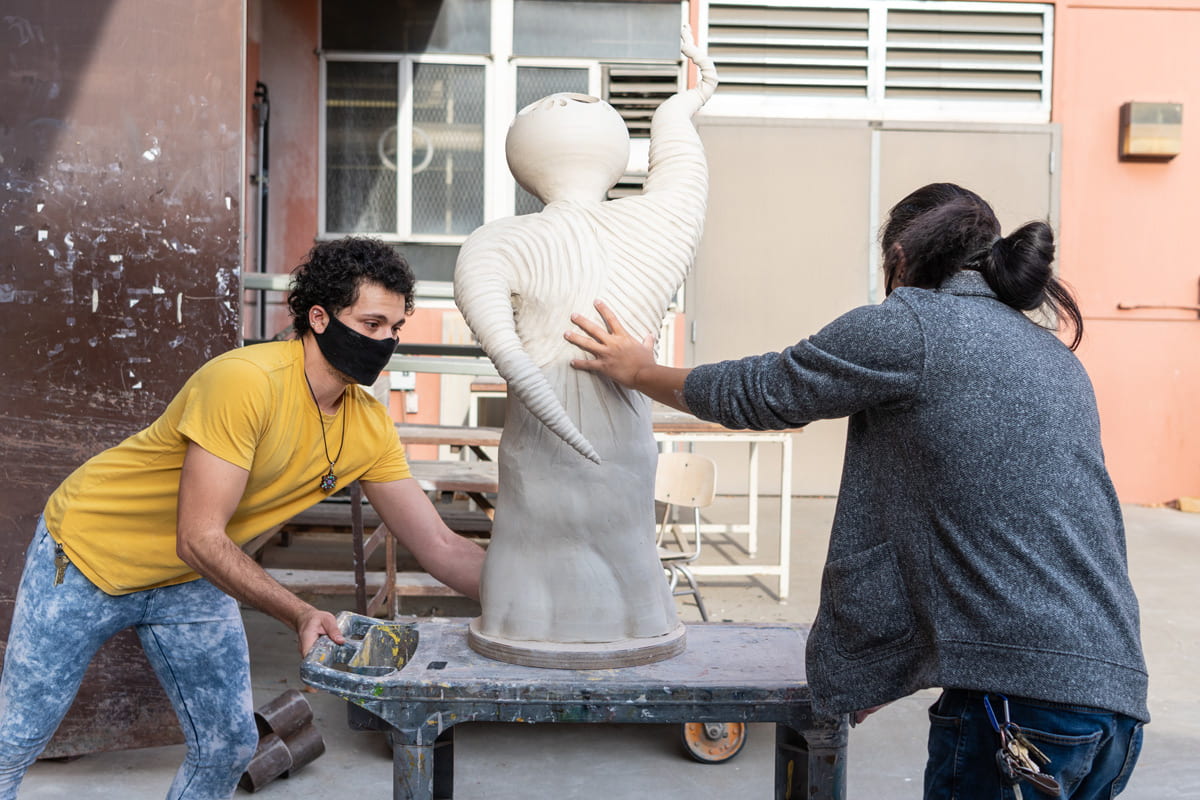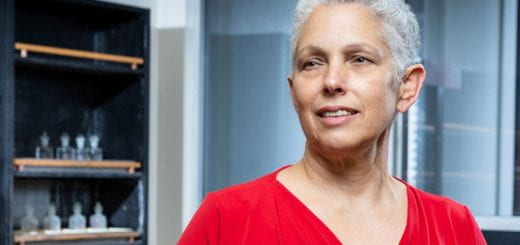Outdoor Ceramics Ready for Frogs from the Sky
Assistant Professor Adam Shiverdecker is an expert sculptor, teacher and the coordinator for spatial art. This fall he’s teaching pottery wheel techniques to intermediate and advanced ceramics students. His class will be mostly in person, held outdoors. His classroom doubles as a parking area for SJSU Facilities Development and Operations.
“We share the space,” Shiverdecker says, “and FD&O has been very gracious.” FD&O parks its white campus service vehicles out of the way so students can sculpt in the ceramics courtyard.
The Department of Art and Art History purchased outdoor furniture, including ten tables and large umbrellas. Students working with clay on their projects disperse to safe radiuses of distance. “We were ready to go, the first day of classes,” Shiverdecker says, and then the campus shut down due to wildfires. “No matter what you anticipate, there’s something else thrown at you right now, because this is 2020,” he laughs. “We’re hopeful no frogs fall from the sky, but if they do, our students are covered—because we have umbrellas!”
For artists, particularly painters, working outside is a venerated tradition, Shiverdecker says. “It’s provided us an opportunity to talk about historical models of learning and teaching. A throwback to plein air painting is a classic, traditional model of art making.”
Shiverdecker says the department usually went through 5,000 to 7,000 pounds of clay per semester. That’s a lot of projects. Firing them all in the kiln—a complicated and technical separate skill—wasn’t something students typically had the opportunity to practice, due in part to the large number of projects. But this semester some will learn. “I’m teaching them how to program kilns, how to pay attention to the color and the smell,” he says. “It’s really allowed more in-depth, meaningful learning.”
Ceramics students were each issued their own cleaning materials, like sponges. “We’ve taken a lot of the shared cleaning tools out of the facility,” he says. “Every student has their own little bucket of cleaning tools, they clean up their space, and I come through and wipe down chairs, stools and tables at the end of the day.”
“Students want to make things that deal with ideas of beauty and grandeur.”
Shiverdecker’s classes include remote learning. Art department faculty members film themselves making art in their home studios, demonstrating “specific processes that are elemental to creating sculpture,” he says. “And also providing a healthy dose of art history along the way.” Shiverdecker says he was pleased with student participation and dialogue. “The Zoom sessions have really helped create community. I’ve seen an uptick this semester in the general easiness the students have exhibited and their ability to engage. We’ve had some really great conversations already.”
Will students make COVID-19-inspired art? “In my classroom practice,” Shiverdecker says, “we are witnessing and practicing,” thinking of art’s purpose in contemporary society. “But people also need an escape—looking more at beauty and celebrating life, escaping the COVID-19 routine. I’ve heard from several students that they just want to make things that deal with ideas of beauty and grandeur. A lot of them are burned out on [the pandemic].”
Like professors in many other disciplines, he is seeing how video instruction improved his in-person teaching. In the past, when students missed class, he says, “usually I would meet with them at the next session and rehash a process or demonstration. This hybrid model actually allows a lot more class time for me to discuss projects with students. I’m not too encumbered by catching up anyone, because it’s all available on video.” Shiverdecker says that post-pandemic he and many of his spatial art colleagues would continue that approach.
But hands-on is essential. “You need the pottery wheel to create work for the class. Our students sign up for that class because they want to learn how to use the tool to create works that are not just utilitarian—cups, mugs and bowls.” Some are future working artists, but many are teachers, he says. They too want to make “sculpture with a dynamic presence.”
Shiverdecker had long discussions with his spatial art colleagues at the other 22 CSU campuses. He learned that SJSU was unique in offering ceramics taught outdoors. “A little feather in our cap, so to speak—that we’re able to be flexible. The university, the college and the department have been really generous and helpful in making this happen. I’m really thankful.”
Departmental discussions had turned to the importance of adapting. “This is the new now, right?” Shiverdecker says. “That’s how I talk to my colleagues: this is how the future of academia is going to be—working in hybrid models, probably for a while. It’s important to bolster our pedagogy and curriculum and meet our students’ needs.”
Students crave in-person instruction and the opportunity to to be around other people—at a safe distance, he says. “Honestly, a lot of us professors miss that interaction too. We like being around the students and being in the studio with them.”






